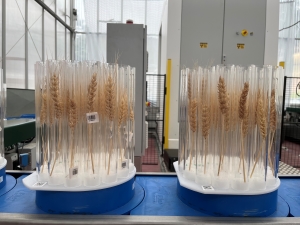CT scans deliver new view for grains research
CT scans deliver new view for grains research
Date: 13 Nov 2021

‘CT scans’ are relatively common when it comes to medical science, but now the sophisticated technology is being adapted to give researchers a new view of plants.
Computed tomography (CT) scanners are regularly used to make cross sectional or three-dimensional X-ray images of human subjects to help with specialist diagnosis in hospitals across the world.
Now that technology has been adapted to help crop science, thanks to investment by the Grains Research Development Corporation (GRDC), which has led to the installation of a specially adapted X-ray CT scanner at the Adelaide node of the Australian Plant Phenomics Facility (APPF).
This custom-built CT scanner will be used by researchers to identify physical plant traits that contribute to improved crop performance, resilience and yield stability.
Being able to create images of the inside of plant structures, seed heads and grains will help researchers identify the effects of genetic differences across multiple breeding lines and assist the search for traits associated with improved tolerance to stresses such as frost and drought.
GRDC Wheat Genetic Technologies Manager, Pip Wilson said the CT scanner was an exciting innovation which would deliver genetic improvements in a range of crop types faster to Australian growers.
“GRDC is committed to investing in new and innovative technology that delivers for industry,” Dr Wilson said.
“This technology will help reduce the time it takes to identify genetic improvements, effectively speeding up the process of delivering improved genetics to breeding companies and then in turn getting new varieties to growers.”
Co-investors in this cutting-edge project include the University of Adelaide, the Australian Plant Phenomics Facility, the University of South Australia, the University of Melbourne, Macquarie University and La Trobe University.
While conventional medical CT scanners rotate around a patient when they are lying down, this system was impractical for scanning plants in pots, let alone entire research populations comprising hundreds of lines of genetic material.
Instead, the team at the APPF and the University of Adelaide worked closely with the Germany-based Fraunhofer Institute for Integrated Circuits and Dutch company PhenoKey to develop a custom design.
Australian Plant Phenomics Facility scientific director Bettina Berger said the specialised design allowed plants and cereals spikes to be carried to the scanner on a conveyor belt and then rotated in front of the CT scanner, rather than having the scanner rotate around the subject as in medical systems.
“The custom design means phenotyping can be done in an automated, high throughput fashion that achieves maximum efficiency for both pre-breeders working on trait discovery and breeders looking to assess breeding lines,” Assoc. Professor Berger said.
In test runs with a similar system, former University of Adelaide PhD student Jessica Schmidt has demonstrated the utility of X-ray CT in measuring the impact on yield of drought and heat stresses. She has used CT images of spike heads and seeds to automatically compare differences in grain size, shape and number across a range of wheat lines.
The next stage of implementation involves researchers undertaking a range of pilot project to validate the CT scanner data. The call for pilot projects will close this Friday, December 17.
“These trials are the final step before opening up for business in 2022,” Assoc. Professor Berger said.
Efforts are also underway to develop software tools and protocols with different soil types and moisture levels that will enable the CT scanner to phenotype root characteristics in soil.
Read more about this innovative technology and what it means for the grains industry.
Contact details
For interviews
A/Prof Bettina Berger, Scientific Director,
Australian Plant Phenomics Facility
08 8313 0825
bettina.berger@adelaide.edu.au
Contact
Toni Somes, GRDC
0436 622 645
toni.somes@grdc.com.au
GRDC Project Code: UOA1806-013AWX,
